A Report on Qualitative and Quantitative Research in Nursing Field
VerifiedAdded on 2023/04/26
|6
|1095
|129
Report
AI Summary
This report provides an analysis of both qualitative and quantitative research articles in the field of nursing. The quantitative study examines nurses' knowledge of hand hygiene and its predictors, while the qualitative study explores the communicative role of nurses in patient care. The report differentiates between four types of qualitative research—phenomenology, ethnography, grounded theory, and case study—highlighting their advantages and disadvantages. It also addresses how trustworthiness can be established in qualitative data analysis and discusses ethical considerations unique to qualitative methods, such as maintaining privacy and avoiding emotional harm to participants. The analysis emphasizes the importance of rigorous data refinement and ethical awareness in conducting and interpreting nursing research.
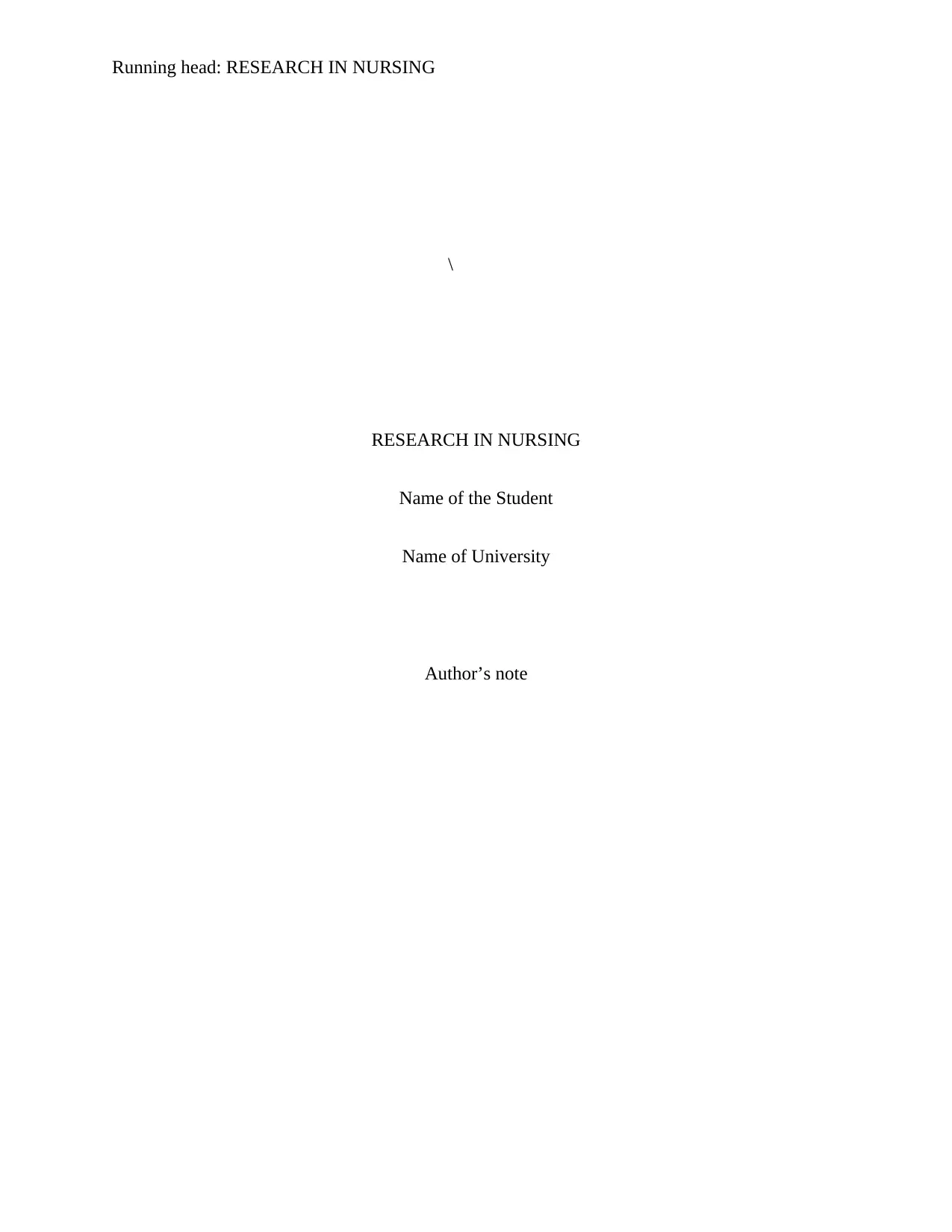
Running head: RESEARCH IN NURSING
\
RESEARCH IN NURSING
Name of the Student
Name of University
Author’s note
\
RESEARCH IN NURSING
Name of the Student
Name of University
Author’s note
Paraphrase This Document
Need a fresh take? Get an instant paraphrase of this document with our AI Paraphraser
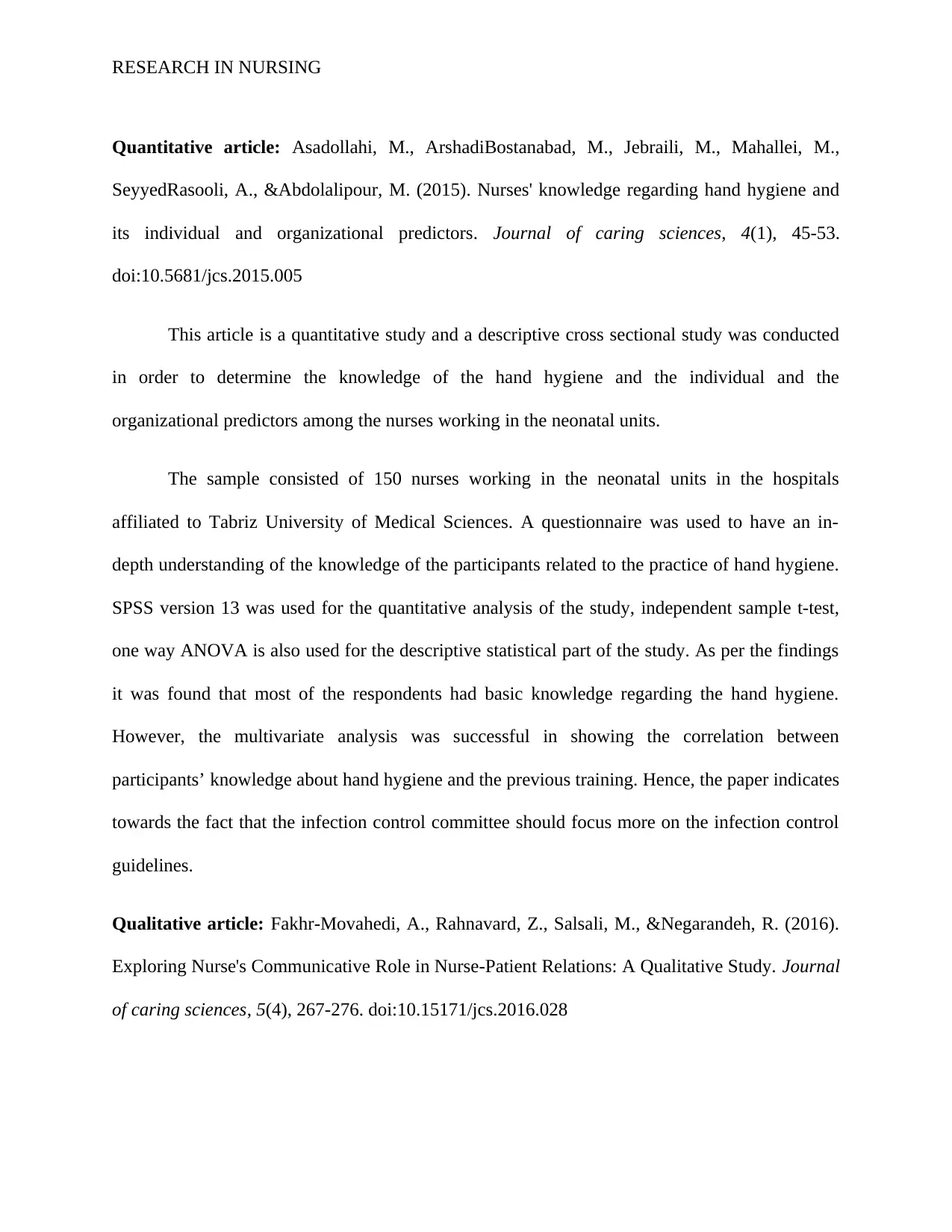
RESEARCH IN NURSING
Quantitative article: Asadollahi, M., ArshadiBostanabad, M., Jebraili, M., Mahallei, M.,
SeyyedRasooli, A., &Abdolalipour, M. (2015). Nurses' knowledge regarding hand hygiene and
its individual and organizational predictors. Journal of caring sciences, 4(1), 45-53.
doi:10.5681/jcs.2015.005
This article is a quantitative study and a descriptive cross sectional study was conducted
in order to determine the knowledge of the hand hygiene and the individual and the
organizational predictors among the nurses working in the neonatal units.
The sample consisted of 150 nurses working in the neonatal units in the hospitals
affiliated to Tabriz University of Medical Sciences. A questionnaire was used to have an in-
depth understanding of the knowledge of the participants related to the practice of hand hygiene.
SPSS version 13 was used for the quantitative analysis of the study, independent sample t-test,
one way ANOVA is also used for the descriptive statistical part of the study. As per the findings
it was found that most of the respondents had basic knowledge regarding the hand hygiene.
However, the multivariate analysis was successful in showing the correlation between
participants’ knowledge about hand hygiene and the previous training. Hence, the paper indicates
towards the fact that the infection control committee should focus more on the infection control
guidelines.
Qualitative article: Fakhr-Movahedi, A., Rahnavard, Z., Salsali, M., &Negarandeh, R. (2016).
Exploring Nurse's Communicative Role in Nurse-Patient Relations: A Qualitative Study. Journal
of caring sciences, 5(4), 267-276. doi:10.15171/jcs.2016.028
Quantitative article: Asadollahi, M., ArshadiBostanabad, M., Jebraili, M., Mahallei, M.,
SeyyedRasooli, A., &Abdolalipour, M. (2015). Nurses' knowledge regarding hand hygiene and
its individual and organizational predictors. Journal of caring sciences, 4(1), 45-53.
doi:10.5681/jcs.2015.005
This article is a quantitative study and a descriptive cross sectional study was conducted
in order to determine the knowledge of the hand hygiene and the individual and the
organizational predictors among the nurses working in the neonatal units.
The sample consisted of 150 nurses working in the neonatal units in the hospitals
affiliated to Tabriz University of Medical Sciences. A questionnaire was used to have an in-
depth understanding of the knowledge of the participants related to the practice of hand hygiene.
SPSS version 13 was used for the quantitative analysis of the study, independent sample t-test,
one way ANOVA is also used for the descriptive statistical part of the study. As per the findings
it was found that most of the respondents had basic knowledge regarding the hand hygiene.
However, the multivariate analysis was successful in showing the correlation between
participants’ knowledge about hand hygiene and the previous training. Hence, the paper indicates
towards the fact that the infection control committee should focus more on the infection control
guidelines.
Qualitative article: Fakhr-Movahedi, A., Rahnavard, Z., Salsali, M., &Negarandeh, R. (2016).
Exploring Nurse's Communicative Role in Nurse-Patient Relations: A Qualitative Study. Journal
of caring sciences, 5(4), 267-276. doi:10.15171/jcs.2016.028
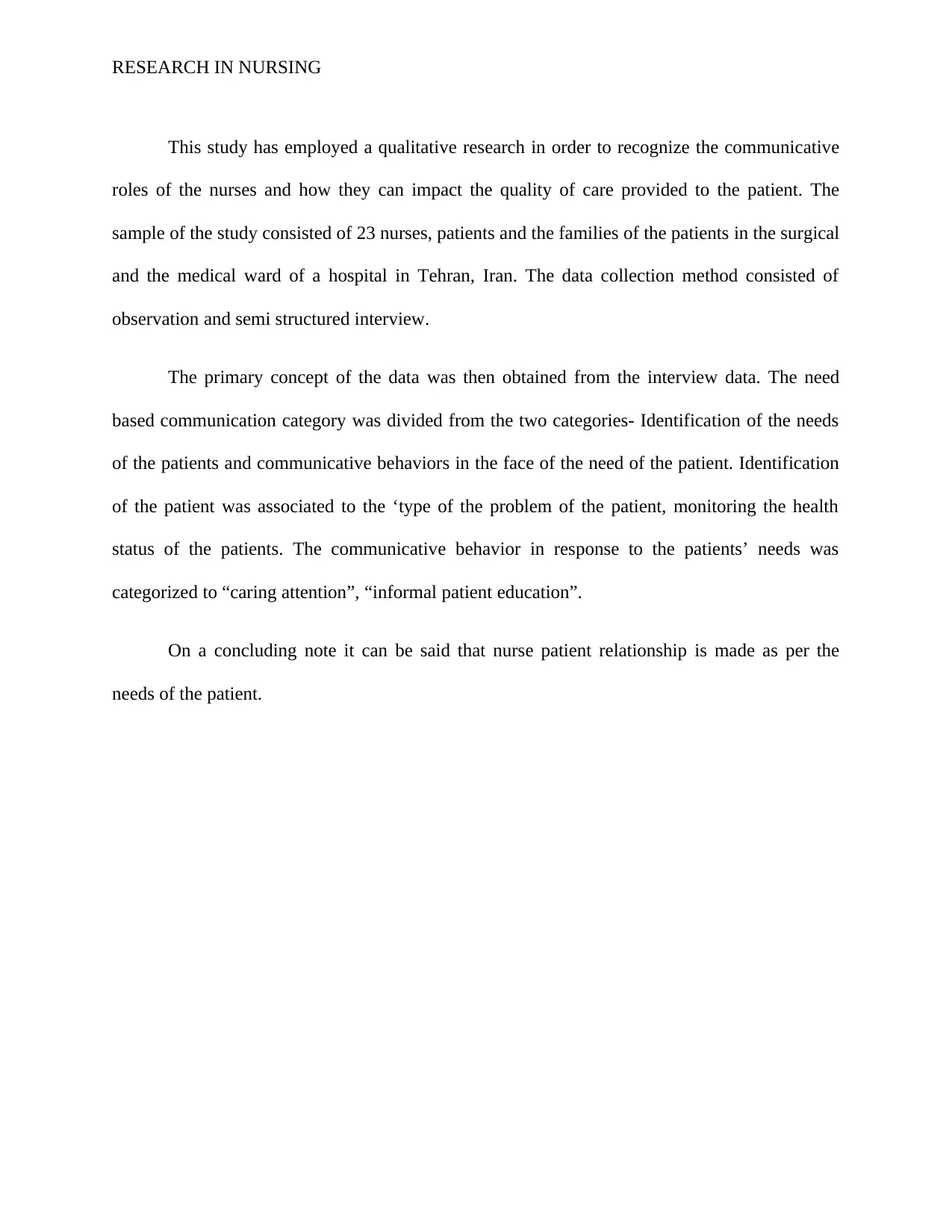
RESEARCH IN NURSING
This study has employed a qualitative research in order to recognize the communicative
roles of the nurses and how they can impact the quality of care provided to the patient. The
sample of the study consisted of 23 nurses, patients and the families of the patients in the surgical
and the medical ward of a hospital in Tehran, Iran. The data collection method consisted of
observation and semi structured interview.
The primary concept of the data was then obtained from the interview data. The need
based communication category was divided from the two categories- Identification of the needs
of the patients and communicative behaviors in the face of the need of the patient. Identification
of the patient was associated to the ‘type of the problem of the patient, monitoring the health
status of the patients. The communicative behavior in response to the patients’ needs was
categorized to “caring attention”, “informal patient education”.
On a concluding note it can be said that nurse patient relationship is made as per the
needs of the patient.
This study has employed a qualitative research in order to recognize the communicative
roles of the nurses and how they can impact the quality of care provided to the patient. The
sample of the study consisted of 23 nurses, patients and the families of the patients in the surgical
and the medical ward of a hospital in Tehran, Iran. The data collection method consisted of
observation and semi structured interview.
The primary concept of the data was then obtained from the interview data. The need
based communication category was divided from the two categories- Identification of the needs
of the patients and communicative behaviors in the face of the need of the patient. Identification
of the patient was associated to the ‘type of the problem of the patient, monitoring the health
status of the patients. The communicative behavior in response to the patients’ needs was
categorized to “caring attention”, “informal patient education”.
On a concluding note it can be said that nurse patient relationship is made as per the
needs of the patient.
⊘ This is a preview!⊘
Do you want full access?
Subscribe today to unlock all pages.

Trusted by 1+ million students worldwide
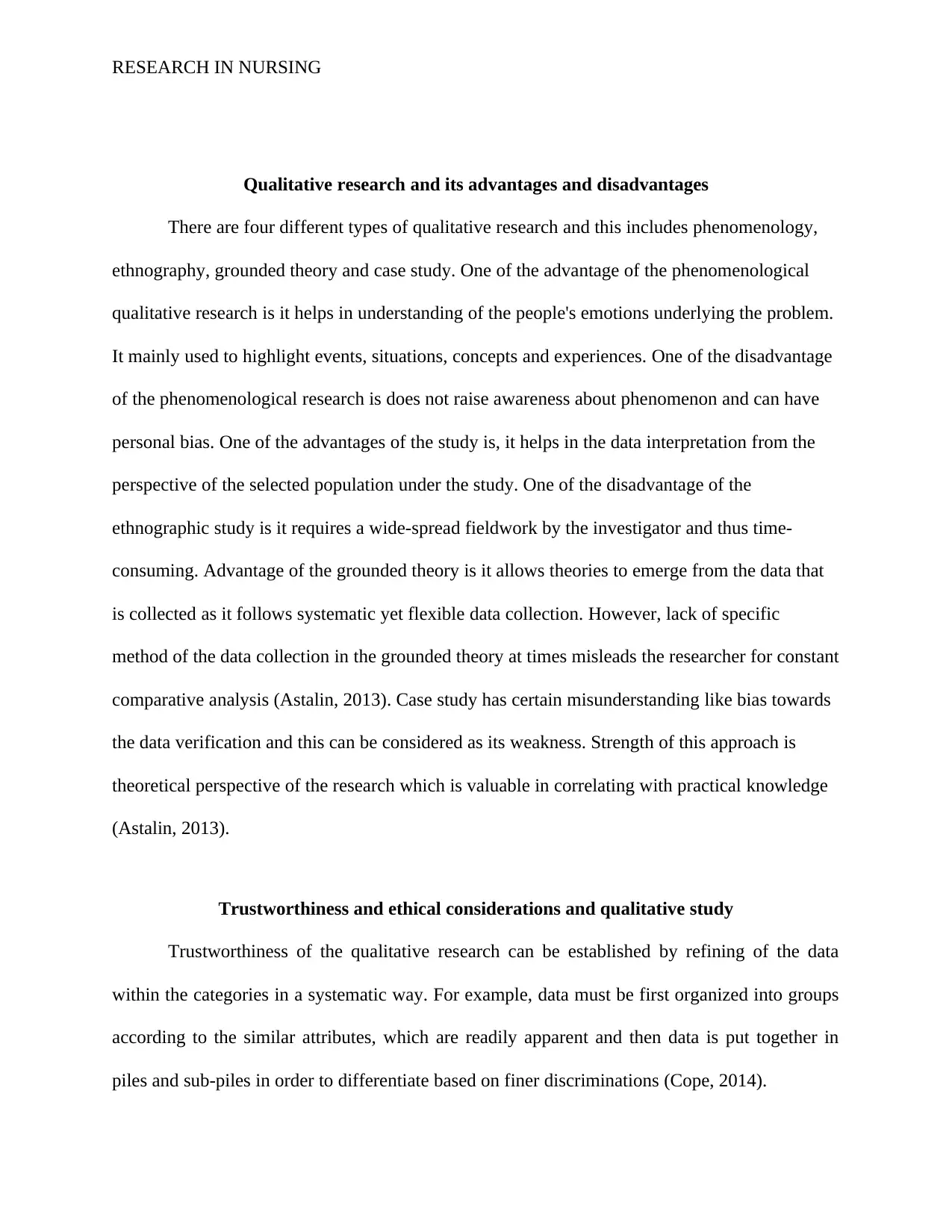
RESEARCH IN NURSING
Qualitative research and its advantages and disadvantages
There are four different types of qualitative research and this includes phenomenology,
ethnography, grounded theory and case study. One of the advantage of the phenomenological
qualitative research is it helps in understanding of the people's emotions underlying the problem.
It mainly used to highlight events, situations, concepts and experiences. One of the disadvantage
of the phenomenological research is does not raise awareness about phenomenon and can have
personal bias. One of the advantages of the study is, it helps in the data interpretation from the
perspective of the selected population under the study. One of the disadvantage of the
ethnographic study is it requires a wide-spread fieldwork by the investigator and thus time-
consuming. Advantage of the grounded theory is it allows theories to emerge from the data that
is collected as it follows systematic yet flexible data collection. However, lack of specific
method of the data collection in the grounded theory at times misleads the researcher for constant
comparative analysis (Astalin, 2013). Case study has certain misunderstanding like bias towards
the data verification and this can be considered as its weakness. Strength of this approach is
theoretical perspective of the research which is valuable in correlating with practical knowledge
(Astalin, 2013).
Trustworthiness and ethical considerations and qualitative study
Trustworthiness of the qualitative research can be established by refining of the data
within the categories in a systematic way. For example, data must be first organized into groups
according to the similar attributes, which are readily apparent and then data is put together in
piles and sub-piles in order to differentiate based on finer discriminations (Cope, 2014).
Qualitative research and its advantages and disadvantages
There are four different types of qualitative research and this includes phenomenology,
ethnography, grounded theory and case study. One of the advantage of the phenomenological
qualitative research is it helps in understanding of the people's emotions underlying the problem.
It mainly used to highlight events, situations, concepts and experiences. One of the disadvantage
of the phenomenological research is does not raise awareness about phenomenon and can have
personal bias. One of the advantages of the study is, it helps in the data interpretation from the
perspective of the selected population under the study. One of the disadvantage of the
ethnographic study is it requires a wide-spread fieldwork by the investigator and thus time-
consuming. Advantage of the grounded theory is it allows theories to emerge from the data that
is collected as it follows systematic yet flexible data collection. However, lack of specific
method of the data collection in the grounded theory at times misleads the researcher for constant
comparative analysis (Astalin, 2013). Case study has certain misunderstanding like bias towards
the data verification and this can be considered as its weakness. Strength of this approach is
theoretical perspective of the research which is valuable in correlating with practical knowledge
(Astalin, 2013).
Trustworthiness and ethical considerations and qualitative study
Trustworthiness of the qualitative research can be established by refining of the data
within the categories in a systematic way. For example, data must be first organized into groups
according to the similar attributes, which are readily apparent and then data is put together in
piles and sub-piles in order to differentiate based on finer discriminations (Cope, 2014).
Paraphrase This Document
Need a fresh take? Get an instant paraphrase of this document with our AI Paraphraser
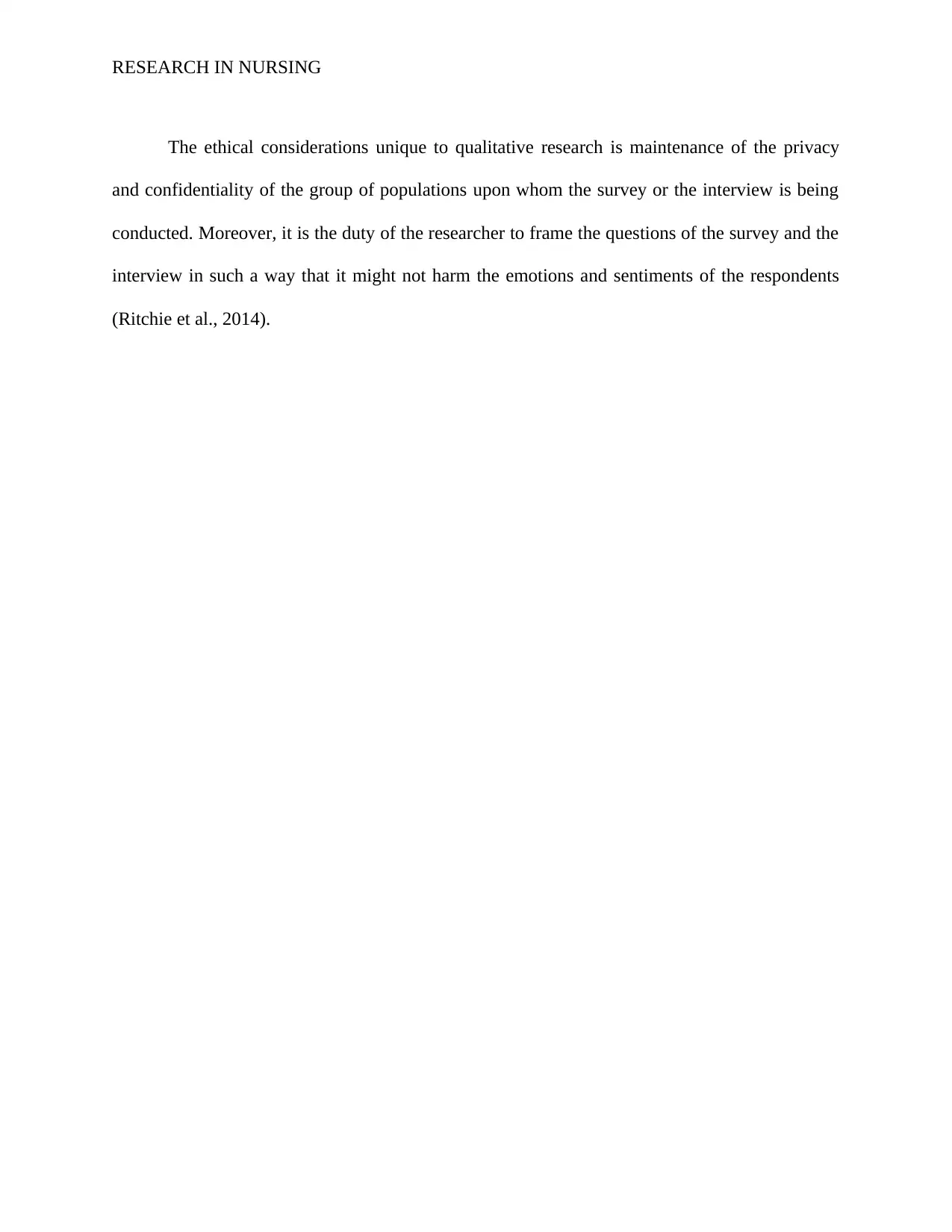
RESEARCH IN NURSING
The ethical considerations unique to qualitative research is maintenance of the privacy
and confidentiality of the group of populations upon whom the survey or the interview is being
conducted. Moreover, it is the duty of the researcher to frame the questions of the survey and the
interview in such a way that it might not harm the emotions and sentiments of the respondents
(Ritchie et al., 2014).
The ethical considerations unique to qualitative research is maintenance of the privacy
and confidentiality of the group of populations upon whom the survey or the interview is being
conducted. Moreover, it is the duty of the researcher to frame the questions of the survey and the
interview in such a way that it might not harm the emotions and sentiments of the respondents
(Ritchie et al., 2014).
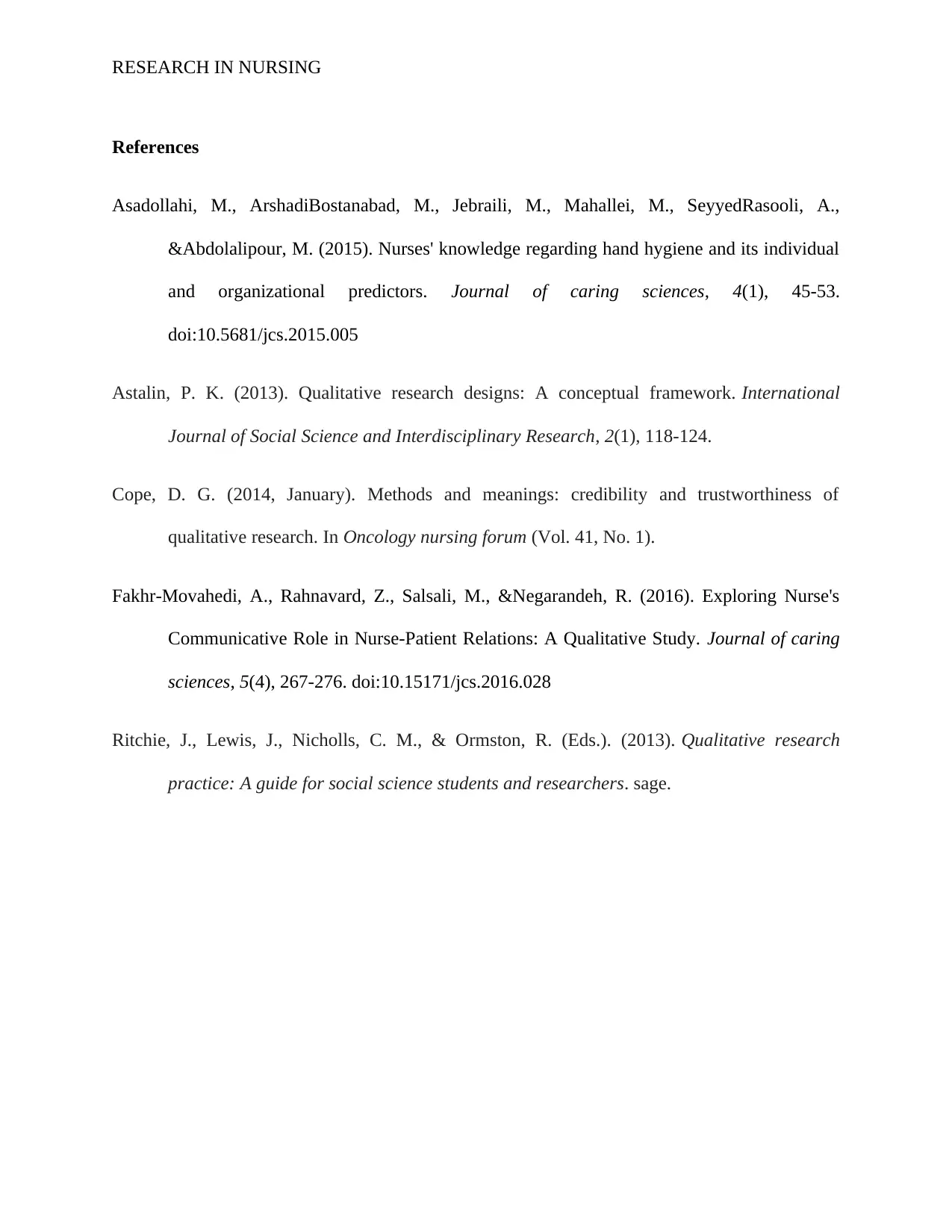
RESEARCH IN NURSING
References
Asadollahi, M., ArshadiBostanabad, M., Jebraili, M., Mahallei, M., SeyyedRasooli, A.,
&Abdolalipour, M. (2015). Nurses' knowledge regarding hand hygiene and its individual
and organizational predictors. Journal of caring sciences, 4(1), 45-53.
doi:10.5681/jcs.2015.005
Astalin, P. K. (2013). Qualitative research designs: A conceptual framework. International
Journal of Social Science and Interdisciplinary Research, 2(1), 118-124.
Cope, D. G. (2014, January). Methods and meanings: credibility and trustworthiness of
qualitative research. In Oncology nursing forum (Vol. 41, No. 1).
Fakhr-Movahedi, A., Rahnavard, Z., Salsali, M., &Negarandeh, R. (2016). Exploring Nurse's
Communicative Role in Nurse-Patient Relations: A Qualitative Study. Journal of caring
sciences, 5(4), 267-276. doi:10.15171/jcs.2016.028
Ritchie, J., Lewis, J., Nicholls, C. M., & Ormston, R. (Eds.). (2013). Qualitative research
practice: A guide for social science students and researchers. sage.
References
Asadollahi, M., ArshadiBostanabad, M., Jebraili, M., Mahallei, M., SeyyedRasooli, A.,
&Abdolalipour, M. (2015). Nurses' knowledge regarding hand hygiene and its individual
and organizational predictors. Journal of caring sciences, 4(1), 45-53.
doi:10.5681/jcs.2015.005
Astalin, P. K. (2013). Qualitative research designs: A conceptual framework. International
Journal of Social Science and Interdisciplinary Research, 2(1), 118-124.
Cope, D. G. (2014, January). Methods and meanings: credibility and trustworthiness of
qualitative research. In Oncology nursing forum (Vol. 41, No. 1).
Fakhr-Movahedi, A., Rahnavard, Z., Salsali, M., &Negarandeh, R. (2016). Exploring Nurse's
Communicative Role in Nurse-Patient Relations: A Qualitative Study. Journal of caring
sciences, 5(4), 267-276. doi:10.15171/jcs.2016.028
Ritchie, J., Lewis, J., Nicholls, C. M., & Ormston, R. (Eds.). (2013). Qualitative research
practice: A guide for social science students and researchers. sage.
⊘ This is a preview!⊘
Do you want full access?
Subscribe today to unlock all pages.

Trusted by 1+ million students worldwide
1 out of 6